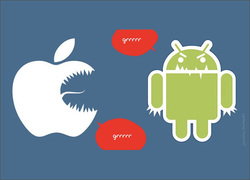
There has been a bitter clash between corporations when it comes to apps, not least because of the frankly petty issue of the physical name of the app shop itself[1]. This battle led to the name change from the Android App Store to Google Play. Apple first claimed the rights to the name `App Store` back in 2011, claiming that the company thought of the name themselves more than 5 years ago. Amazon dismissed this, stating that the term was generic and wasn't something to be fought for. After a long (expensive) struggle, Apple conceded that there was no need to pursue it, as “With more than 900,000 apps and 50 billion downloads, customers know where they can purchase their favorite apps.”
The two main competitors, Apple and Android are not as similar as most people think. Their main differences lie in their app guidelines. In order to publish a digital app on the IOS store, one must conform to a number of constricting rules and regulations[2] in order to ensure consistency and obedience within the store. Most of said rules are routine; and serve more for safety than control, however Android and other app publishers have more of a flexible look on things, and are seen to be much more easy going when it comes to what is published.
The two main competitors, Apple and Android are not as similar as most people think. Their main differences lie in their app guidelines. In order to publish a digital app on the IOS store, one must conform to a number of constricting rules and regulations[2] in order to ensure consistency and obedience within the store. Most of said rules are routine; and serve more for safety than control, however Android and other app publishers have more of a flexible look on things, and are seen to be much more easy going when it comes to what is published.

Apple's case was not helped by the fact that their recent IOS 7 update allowed hackers to access the personal data of the public through a security glitch[3]. It is this and other issues that publishers must consider when releasing or even developing an app for use by said public.
Android is not without its shortcomings, for example in the adult app industry; where published dating apps were charging for a simply non-existent service. Perhaps Apple had the right idea after all with their strict guidelines.
Word count: 306
Android is not without its shortcomings, for example in the adult app industry; where published dating apps were charging for a simply non-existent service. Perhaps Apple had the right idea after all with their strict guidelines.
Word count: 306
References
Image 1: http://www.androidheadlines.com/wp-content/uploads/2010/09/apple_vs_android.jpg (Accessed 25/11/2013)
Image 2: http://mediawiremobile.com/blog/wp-content/uploads/2013/05/google-vs-apple1-500x227.jpg (Accessed 25/11/2013)
[1] Ogg, E. (July 2013). Apple, Amazon stop fighting over who gets to use “App Store” name. http://gigaom.com/2013/07/09/apple-amazon-stop-fighting-over-who-gets-to-use-app-store-name/ (Accessed 25/11/2013)
[2] Clover, J. (Aug 2013). Apple Releases New App Store Review Guidelines with Updated Rules for Kids Apps, Gambling Apps. http://www.macrumors.com/2013/08/14/apple-releases-new-app-store-review-guidelines-with-updated-info-kids-apps-gambling-app-rules/ (Accessed 25/11/2013)
[3] Brown, A. (Oct 2013). Android v Apple: the battle of the apps http://news.alaric.com/industry-news/mobile/android-v-apple-the-battle-of-the-apps/ (Accessed 25/11/2013)
Image 1: http://www.androidheadlines.com/wp-content/uploads/2010/09/apple_vs_android.jpg (Accessed 25/11/2013)
Image 2: http://mediawiremobile.com/blog/wp-content/uploads/2013/05/google-vs-apple1-500x227.jpg (Accessed 25/11/2013)
[1] Ogg, E. (July 2013). Apple, Amazon stop fighting over who gets to use “App Store” name. http://gigaom.com/2013/07/09/apple-amazon-stop-fighting-over-who-gets-to-use-app-store-name/ (Accessed 25/11/2013)
[2] Clover, J. (Aug 2013). Apple Releases New App Store Review Guidelines with Updated Rules for Kids Apps, Gambling Apps. http://www.macrumors.com/2013/08/14/apple-releases-new-app-store-review-guidelines-with-updated-info-kids-apps-gambling-app-rules/ (Accessed 25/11/2013)
[3] Brown, A. (Oct 2013). Android v Apple: the battle of the apps http://news.alaric.com/industry-news/mobile/android-v-apple-the-battle-of-the-apps/ (Accessed 25/11/2013)


 RSS Feed
RSS Feed